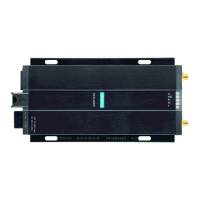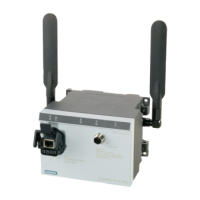Technical basics
4.13 Spanning Tree
SCALANCE W780/W740 to IEEE 802.11n Web Based Management
Configuration Manual, 08/2018, C79000-G8976-C267-13
73
RSTP, MSTP, CIST
Rapid Spanning Tree Protocol (RSTP)
One disadvantage of STP is that if there is a disruption or a device fails, the network needs
to reconfigure itself: The devices start to negotiate new paths only when the interruption
occurs. This can take up to 30 seconds. Fur this reason, STP was expanded to create the
"Rapid Spanning Tree Protocol" (RSTP, IEEE 802.1w). This differs from STP essentially in
that the devices are already collecting information about alternative routes during normal
operation and do not need to gather this information after a disruption has occurred. This
means that the reconfiguration time for an RSTP controlled network can be reduced to a few
seconds.
This is achieved by using the following functions:
● Edge ports (end node port)
Edge ports are ports connected to an end device.
A port that is defined as an edge port is activated immediately after connection
establishment. If a spanning tree BPDU is received at an edge port, the port loses its role
as edge port and it takes part in (R)STP again. If no further BPDU is received after a
certain time has elapsed (3 x hello time), the port returns to the edge port status.
● Point-to-point (direct communication between two neighboring devices)
By directly linking the devices, a status change (reconfiguration of the ports) can be made
without any delays.
● Alternate port (substitute for the root port)
A substitute for the root port is configured. If the connection to the root bridge is lost, the
device can establish a connection over the alternate port without any delay due to
reconfiguration.
● Reaction to events
Rapid spanning tree reacts to events, for example an aborted connection, without delay.
There is no waiting for timers as in spanning tree.
● Counter for the maximum bridge hops
The number of bridge hops a package is allowed to make before it automatically
becomes invalid.
In principle, therefore with rapid spanning tree, alternatives for many parameters are
preconfigured and certain properties of the network structure taken into account to reduce
the reconfiguration time.
Multiple Spanning Tree Protocol (MSTP)
The Multiple Spanning Tree Protocol (MSTP) is a further development of the Rapid
Spanning Tree Protocol. Among other things, it provides the option of operating several
RSTP instances within different VLANs or VLAN groups and, for example, making paths
available within the individual VLANs that the single Rapid Spanning Tree Protocol would
globally block.

